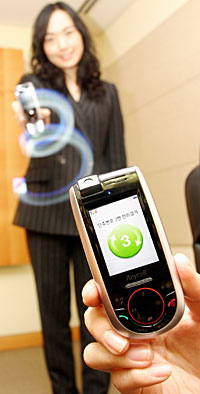
Samsung Electronics unveiled the world's first 3D movement recognition mobile phone. Accelerometer is built in to accurately calculate and ascertain movement in three dimensional space and then carry out commands according to those calculations.
Sophisticated sensing technology calculates the direction in which the mobile phone is moving as well as its speed of movement. The capability extends beyond the identification of the general locus to include precise recognition of small and rapid movements as well as alphanumeric symbols.
The recognition of moving shapes in 3D space, using only sensors built into a mobile phone, is a daunting task. Samsung has developed and commercialized a moving algorithm to solve this problem.
Development of 3D movement recognition technology was a joint project between Samsung Electronics and the Samsung Advanced Institute of Technology. The project has resulted in applications for twenty-two domestic and foreign patents and fourteen technical papers were presented at leading academic societies.
To date, movement sensors in mobile phones have been limited to slope calculations. However, the SCH-S310 can recognize continuous movement in three dimensional space.
Mobile phone input devices to date include the keypad, touch screen and voice recognition. In the future, however, 3D movement recognition technology will become an important user interface and revolutionize mobile phone designs and features.
This technology will do away with the need for complex keypads on mobile phones, MP3 players, digital cameras and other handheld products. This will particularly effect the way games are played on a mobile phone. Many functions will be controlled by movement instead of buttons.
Samsung Electronics President Lee Ki-tae says, "Our new movement recognition technology opens a new chapter in natural communication. We will continue to work on technology breakthroughs for mobile phones that make life more convenient for people."
The Samsung Electronics SCH-S310 uses 3D motion recognition technology for user interface. A "beat box" can be created that will set the phone apart from others on the market with music functions.
User interface: The user can write the number three in the air. The mobile phone can read this movement and then dial three. Shaking the phone twice will conclude a call or delete spam messages.
The user can draw a O or X in the air with the phone, which will recognize it and respond with a voice message yes or no. Move the phone sharply to the right and the selection on the MP3 play function will move to the next tune on the list; move it to the left, and the selection will back up one number.
Moreover, Samsung has already developed movement-controlled functions that will be adopted on later models. These include switching from landscape to portrait when shooting video or snapping a still picture, or preventing the picture from becoming blurred from hand movement. Games will be played by moving the phone up, down, right or left, instead of pressing buttons. The phone will also be able to sense changes in body movement and provide advice on dieting or other health tips.
The motion beat box function enables the user to select a particular sound from the menu such as drum, tambourine, scratch or clap. Then he or she shakes the mobile phone and the beat will be re-created in rhythm with the motion. This enables the user to keep time with any tune being played.
With the music performance function, the phone will begin to play music after it is shaken by the user. The sensors in the phone identify the movement and adjust the beat accordingly.
Moreover, the Samsung SCH-S310 has a magnetic sensor built in that serves as a compass.
Finally, the latest mobile marvel from Samsung applies a fresh new user interface. The intenna slide design comes with GPS, 1.3M-pixel camera, music-on-demand, and mobile banking capabilities.